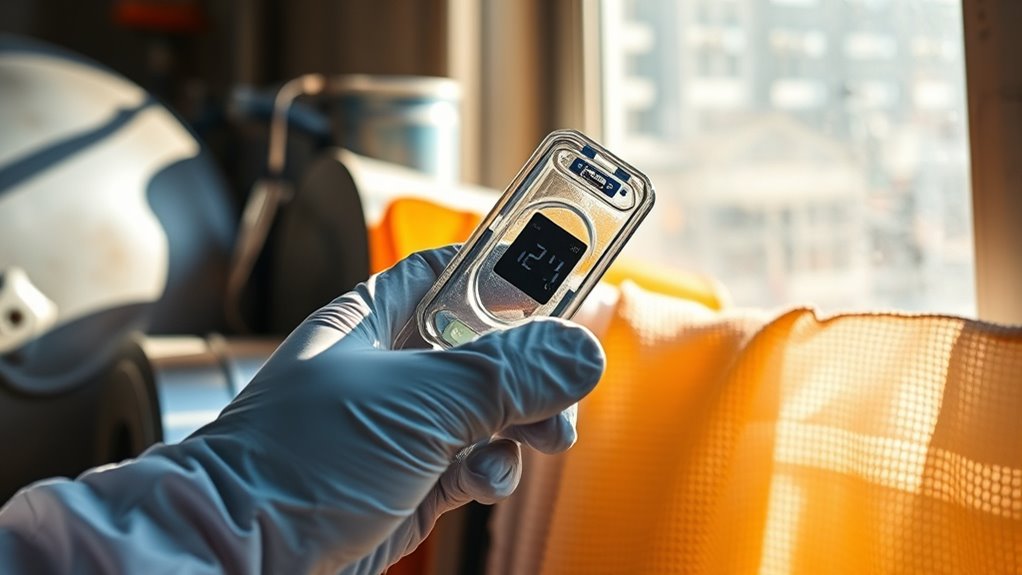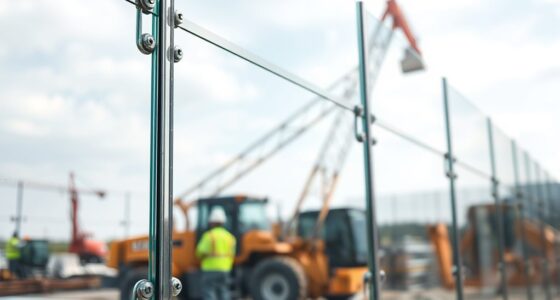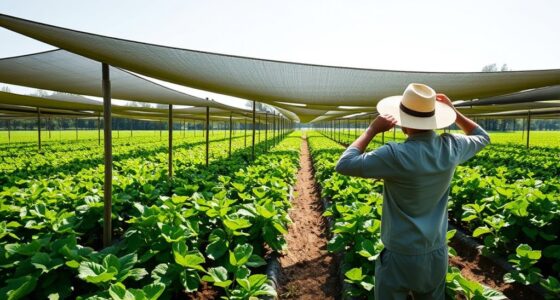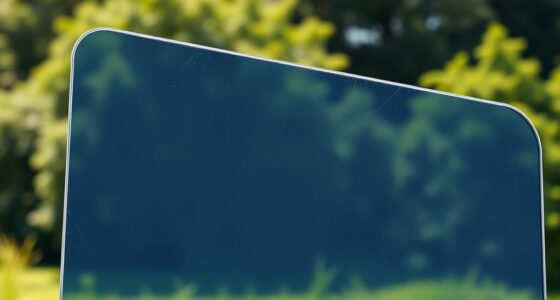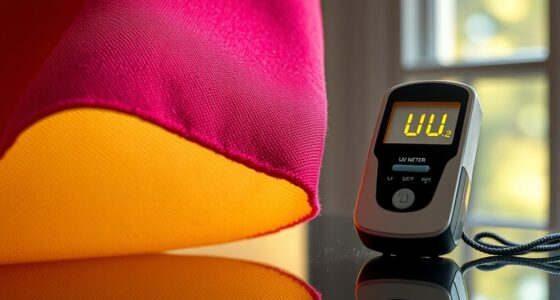Protecting your materials from UV damage involves choosing UV-resistant options, applying protective coatings with UV inhibitors, and using physical barriers like shade structures or UV-blocking films. Regular inspections and maintenance help catch early signs of deterioration, while proper storage prevents unnecessary exposure. Opting for UV-stabilized materials and additives boosts durability. Implementing these proven strategies ensures longevity, and if you want to discover even more effective tips, this guide will show you how to maximize your UV protection efforts.
Key Takeaways
- Use UV-resistant coatings, sealants, and films to shield materials from harmful UV rays effectively.
- Store items in dark, cool environments and protect outdoor materials with covers or shade structures.
- Regularly inspect and maintain protective layers to ensure ongoing UV defense and prevent deterioration.
- Select UV-stable materials and additives during manufacturing for enhanced longevity and resistance.
- Keep detailed records of material condition and protective measures to optimize maintenance and extend lifespan.
Understanding How UV Radiation Damages Materials
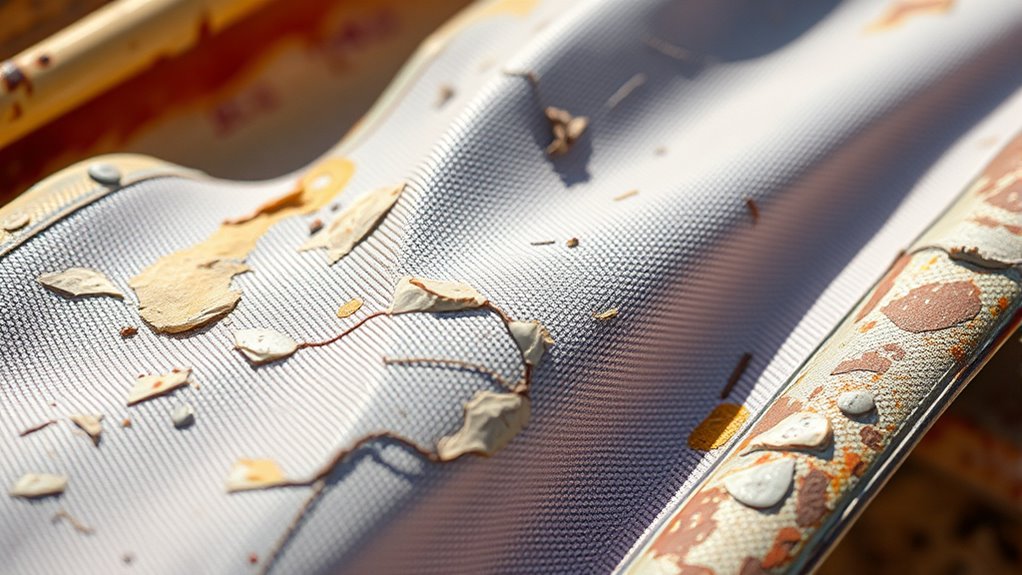
UV radiation can cause significant damage to materials by breaking down their molecular structures. The key factor is the UV wavelength, which determines how deeply UV rays penetrate and affect a material. Shorter wavelengths carry more energy, making them more destructive, leading to faster material degradation. When UV radiation hits a surface, it can break chemical bonds within polymers, plastics, fabrics, and paints. This process weakens the material’s structure, causing cracking, fading, and loss of integrity over time. You might notice discoloration or brittleness as a result. Understanding how UV wavelength influences material degradation helps you recognize why certain materials deteriorate faster when exposed to sunlight. Additionally, the material composition plays a crucial role in its resistance to UV damage. Protecting your materials from UV exposure is essential to extend their lifespan and maintain their appearance.
Recognizing The Types Of Materials Most Vulnerable To UV

Certain materials are more susceptible to UV damage because their chemical structures easily break down when exposed to sunlight. Fabrics like cotton, polyester, and nylon tend to suffer fabric deterioration, losing strength and color over time. Plastics such as polycarbonate, PVC, and acrylic are vulnerable to plastic degradation, becoming brittle or discolored. To visualize this, consider the following table:
| Material Type | Common Examples | UV Vulnerability |
|---|---|---|
| Natural fabrics | Cotton, Wool | High risk of deterioration |
| Synthetic fabrics | Polyester, Nylon | Moderate risk |
| Soft plastics | PVC, Acrylic | High risk of degradation |
| Hard plastics | Polycarbonate, ABS | Moderate to high risk |
UV exposure can accelerate the aging process of these materials, making proper UV protection essential for longevity.
Choosing The Right Protective Coatings And Sealants
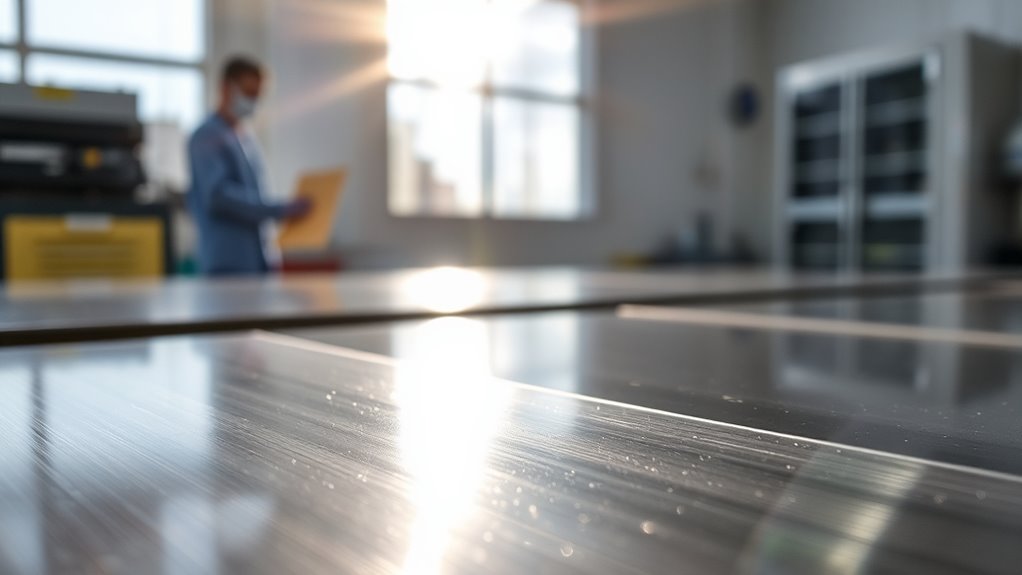
To effectively protect vulnerable materials from UV damage, selecting the right coatings and sealants is vital. You need to take into account coating formulations that include UV inhibitors, making certain they block or absorb harmful rays effectively. Look for products specifically designed for UV resistance, as not all coatings provide the same level of protection. When applying sealants, follow proper application techniques to guarantee even coverage and adhesion, which is essential for durability. Clean surfaces thoroughly before coating to maximize effectiveness. Use appropriate tools to avoid air bubbles or missed spots. Keep in mind that a well-chosen coating or sealant, combined with correct application techniques, can substantially extend your material’s lifespan and maintain its appearance in the face of UV exposure. Additionally, understanding the business trends in alternative investments can help you choose coatings that offer long-term value and stability.
Implementing Physical Barriers To Block Out UV Rays
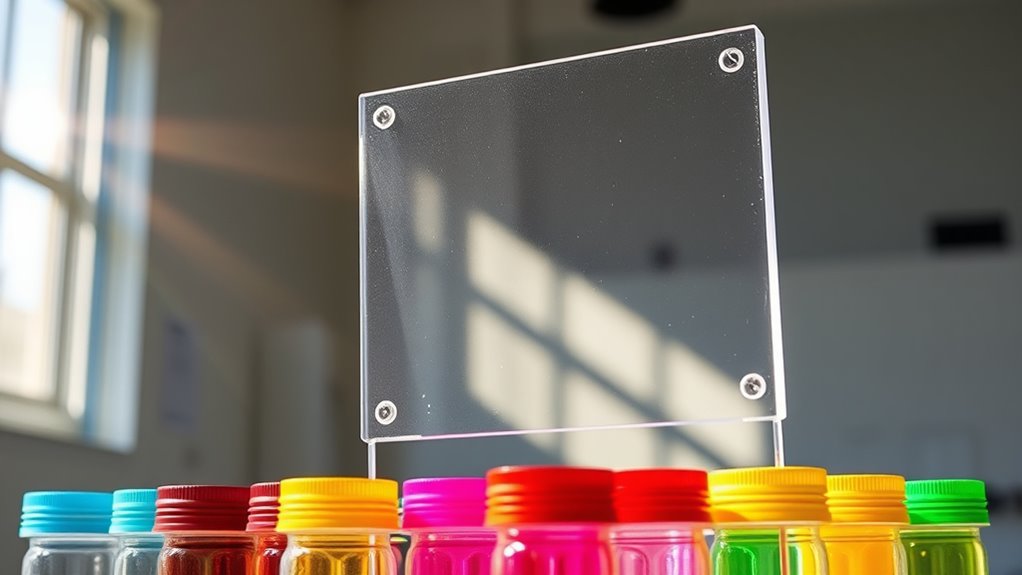
Implementing physical barriers is an effective way to block out UV rays and protect your materials. UV-blocking coverings, shade structures, and protective layers work together to reduce exposure. By choosing the right combination, you can markedly extend the lifespan of your materials and maintain their integrity.
UV-Blocking Coverings
UV-blocking coverings serve as effective physical barriers that prevent harmful ultraviolet rays from reaching sensitive materials or skin. These coverings include UV blocking fabrics and window films, both designed to filter out UV radiation. UV blocking fabrics are ideal for clothing, curtains, or upholstery, providing a portable shield. Window films are applied directly to glass surfaces, blocking UV rays indoors. Use the table below to compare their features:
| Feature | UV Blocking Fabrics | Window Films |
|---|---|---|
| Application | Clothing, curtains | Windows, glass surfaces |
| UV Protection Level | High, customizable | Moderate to high |
| Durability | Washable, flexible | Permanent, UV resistant |
| Cost | Moderate | Varies, often cost-effective |
Additionally, advances in AI-powered technology are being utilized to develop more effective UV protection solutions, such as smart fabrics that can adapt their UV blocking properties based on environmental conditions.
Shade Structures Effectiveness
Shade structures, such as pergolas, awnings, and canopies, act as effective physical barriers that substantially reduce UV exposure in outdoor spaces. Their effectiveness depends on design, material, and placement, making an effectiveness assessment essential. A well-designed shade structure can block up to 90% of UV rays, depending on fabric density and coverage area. When evaluating shade structures, consider factors like angle, height, and the material’s UV protection level. An accurate effectiveness assessment helps you determine if the structure provides sufficient protection for users and underlying materials. Properly designed shade structures are a reliable way to minimize UV-related damage outdoors while offering comfort and safety. Regular inspections ensure they maintain their protective capabilities over time. Understanding material quality is crucial to ensure the longevity and effectiveness of the shade in blocking harmful rays.
Protective Material Layers
To effectively block out harmful UV rays, adding protective material layers creates a essential physical barrier between the sun and your surfaces or skin. UV reflective coatings are a key component, as they bounce UV rays away, reducing their impact. These coatings can be applied to a variety of materials, enhancing their UV resistance without sacrificing material flexibility. Flexible coatings allow you to maintain the shape and function of your surfaces while providing strong UV protection. By choosing layered materials with UV reflective properties, you improve durability and longevity, preventing fading and degradation. Implementing these physical barriers is a straightforward way to shield sensitive surfaces and skin from harmful ultraviolet radiation, ensuring safety and preserving material integrity over time.
Regular Maintenance And Inspection Strategies
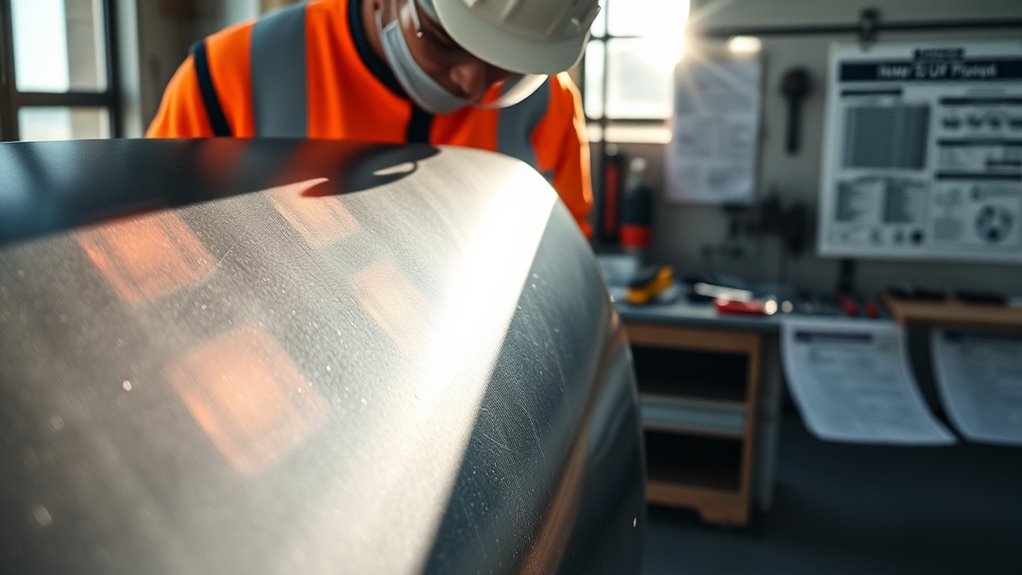
Regular maintenance and inspection are essential to ensuring your materials remain effectively protected from UV damage. By performing routine checks, you can catch early signs of deterioration and address issues before they worsen. Keeping detailed records helps track the condition of your materials over time, guiding maintenance schedules and preventing oversight. Consistent inspections allow you to assess protective layers, identify cracks or fading, and verify UV-resistant coatings are intact. Regularly cleaning surfaces removes debris that can accelerate UV damage. Additionally, monitoring environmental factors like sunlight exposure helps optimize protection strategies. Incorporating UV protection measures into your maintenance routine can significantly extend the lifespan of your materials. Implementing a structured approach guarantees your materials stay durable and safe. Effective record keeping and routine checks form the backbone of a proactive UV protection plan, prolonging the lifespan of your materials.
Utilizing UV-Resistant Materials And Additives
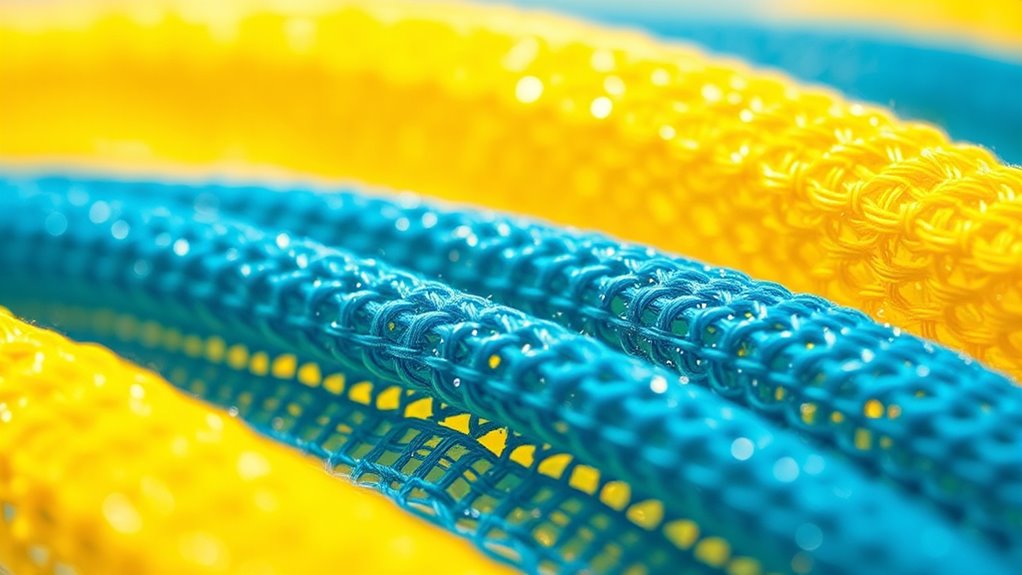
Choosing materials with built-in UV resistance helps your products withstand sunlight exposure longer. Incorporating UV stabilizers during manufacturing can markedly enhance durability and prevent deterioration. Fabric decorating markers can also be used to add protective coatings or labels that reflect UV rays, further extending the lifespan of your items. By selecting the right materials and additives, you guarantee your assets stay protected over time.
Selecting Durable Materials
When selecting materials for outdoor use, prioritizing UV-resistant options can notably extend their lifespan. Look for durable materials that naturally resist UV damage or are enhanced with UV-stable coatings. Eco-friendly coatings, for example, protect surfaces while reducing environmental impact. Biodegradable plastics designed for outdoor applications can also offer sustainable durability when combined with UV inhibitors. Choosing the right materials minimizes the need for frequent replacements and maintenance. Additionally, understanding the UV protection capabilities of different materials can help in making informed choices for long-term resilience. Consider these factors: – Natural UV resistance of certain plastics or composites – Application of eco friendly coatings for added protection – Use of biodegradable plastics with UV stabilizers – Construction materials with inherent UV durability – Compatibility with UV stabilizers for long-term resilience
Incorporating UV Stabilizers
Incorporating UV stabilizers into materials enhances their resistance to sun damage by actively blocking or absorbing harmful ultraviolet rays. These additives reduce UV penetration, preventing premature fading, cracking, and degradation. With stabilizer longevity, your materials stay protected longer, saving you money and effort. You’re investing in durability and peace of mind against the harshest sunlight. To help you visualize, here’s a comparison:
| Benefit | Impact |
|---|---|
| Reduced UV penetration | Keeps colors vibrant and intact |
| Longer stabilizer life | Extends material’s lifespan |
| Enhanced durability | Fights off sun-induced damage |
| Cost-effective protection | Saves replacement costs |
| Peace of mind | Confidence in material resilience |
Choosing the right UV stabilizer means your materials will withstand sun exposure, maintaining their strength and beauty over time. UV resistance is a key factor in selecting the most effective additives for your needs.
Best Practices For Storage And Handling
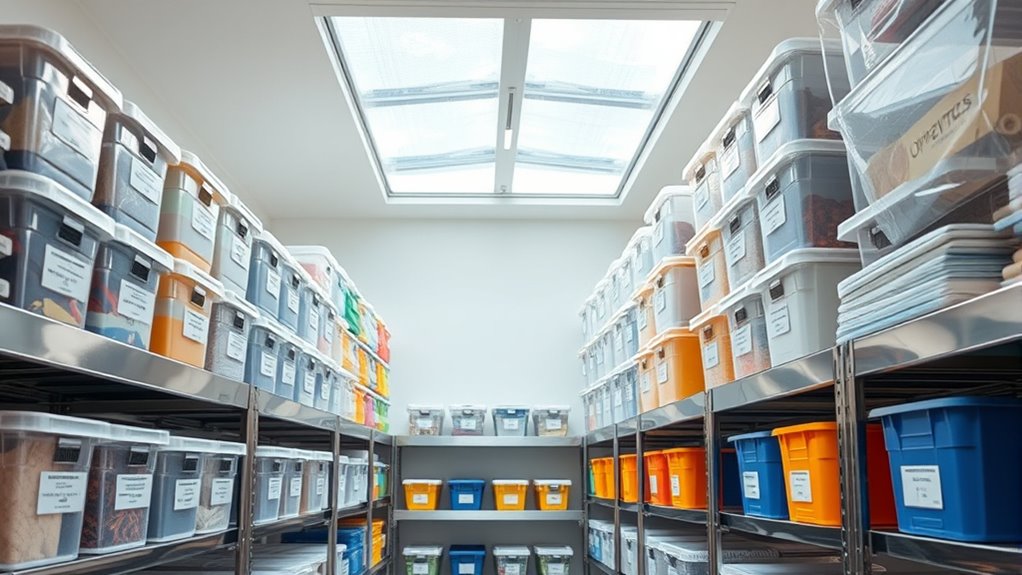
To guarantee materials remain protected from UV damage, proper storage and handling are essential. Following storage guidelines and handling precautions helps prevent premature degradation and maintains material integrity. Store materials in a cool, dark place away from direct sunlight, and avoid exposure during transport. Use UV-resistant containers or covers when handling materials outdoors. Keep materials upright, and avoid stacking heavy objects that can cause pressure damage. Ensure containers are tightly sealed to prevent exposure to air and UV rays. Regularly inspect stored materials for signs of damage or deterioration. Adhering to these best practices minimizes UV-related harm and prolongs the lifespan of your materials. Additionally, understanding material sensitivities can help tailor storage methods for specific items.
Cost-Effective Tips To Maximize UV Protection

Implementing cost-effective strategies can substantially extend the lifespan of your materials without breaking the bank. Start by choosing affordable UV-resistant coatings or sprays designed for your specific materials. Regularly inspecting and maintaining surfaces helps catch early signs of UV damage, preventing costly repairs later. Use shade structures or positioning techniques to reduce direct sun exposure, which offers significant cost savings over time. Consider applying UV protective films or covers that are easy to install and remove, providing ongoing material longevity. Additionally, batching maintenance tasks saves resources and ensures consistent protection. By adopting these simple measures, you effectively maximize UV protection, boost material longevity, and enjoy better cost savings, all while safeguarding your investments from premature deterioration caused by UV exposure.
Frequently Asked Questions
How Do UV Protection Measures Affect Material Longevity and Performance?
UV protection measures boost your material’s durability and performance by preventing UV-induced degradation. By shielding materials from harmful rays, you reduce cracking, fading, and weakening over time. This proactive approach guarantees your materials stay functional longer and perform at their best under various conditions. Implementing UV protection is a smart way to enhance material longevity, saving you money on repairs and replacements while maintaining high performance levels in your projects.
Are There Environmental Considerations When Choosing UV Protective Coatings?
When choosing UV protective coatings, you should consider environmental impacts. Eco-friendly formulations and renewable resources minimize harm to ecosystems and reduce your carbon footprint. Imagine a coating that shields your materials while seamlessly blending into nature’s balance—this is possible with sustainable options. By prioritizing environmentally conscious choices, you protect your materials and support a healthier planet, ensuring your solutions are both effective and responsible.
Can Uv-Resistant Materials Be Recycled or Disposed of Safely?
Yes, UV-resistant materials can be recycled or disposed of safely, but recycling challenges may arise due to their chemical composition. You should follow proper disposal methods, such as designated waste streams or specialized recycling facilities, to prevent environmental harm. Check local regulations and manufacturer guidelines, as some UV-resistant coatings require specific handling. Proper disposal guarantees safety and minimizes environmental impact, helping you manage UV-protected materials responsibly.
What Are the Latest Innovations in UV Protection Technology?
You might think UV protection technology hasn’t evolved much, but nanotechnology advancements are revolutionizing it. These innovations enable the creation of ultra-thin, highly effective UV-blocking coatings. Bio-inspired coatings mimic natural defenses, such as those found in certain plants or animals, providing enhanced durability and environmental friendliness. Together, these developments are making UV protection more efficient, sustainable, and adaptable for various materials, ensuring longer-lasting safety and performance.
How Do Climate Conditions Influence UV Damage and Protection Strategies?
Climate conditions greatly influence UV damage and protection strategies. You need to contemplate climate patterns, such as high temperatures and humidity, which can accelerate UV degradation of materials. UV variability, caused by seasonal changes or weather fluctuations, also affects how much protection you require. To effectively shield your materials, adapt your strategies based on these climate factors, using UV-resistant coatings or coverings suited to specific environmental conditions.
Conclusion
By understanding UV damage and taking proactive steps, you can keep your materials safe and looking sharp—no need to summon a wizard, just smart choices. Regular maintenance, proper coatings, and smart storage are your best allies, helping you avoid costly repairs down the line. Think of it as your modern-day armor against the sun’s rays, ensuring your materials stay protected and durable for years to come. Stay vigilant, and your efforts will truly stand the test of time.
